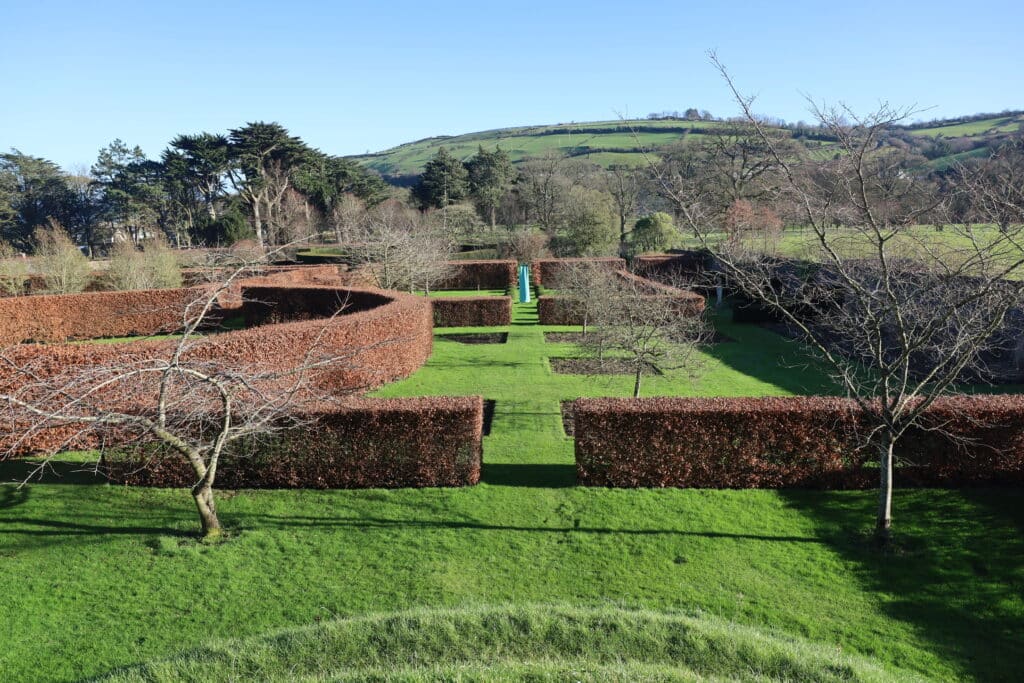We are still planting at Glenarm, especially after a couple of bouts of prolonged rainfall – beauteous rain! In our lighter sandy loam, Magnesium becomes short and shows, in plants such as Rhododendron, Camellia and Skimmia, as yellowing of the lamina of the leaf, while the veins remain verdant and green. The solution is to scatter some Epsom Salts, Magnesium sulphate around the root zone, ideally just before a good dose of rain. The free Magnesium is assimilated easily by the root. We start feeding now with a high nitrogenous liquid feed. I use Universol Green now and again six weeks later. Six weeks after that, I switch to Universol Violet, a high Potassium foliar feed. I use this regimen on young Rhododendron, Magnolia, Camellia and Skimmia and they all respond well. I think this is a great means of helping these plants establish quickly.
We are still sowing. I am trialling a few new species from New Zealand: Agathis australis, Cyperus ustulatus and Apodasmia similis. The Kauri, Agathis australis, can be grown from seed, but the seed must be fresh. If successful, the plants can be grown close together in stands to form ‘Rickers’, young straight pines between 30 and 50 years old, which can be used as telegraph poles in New Zealand. I hope to have a stand of Rickers at Glenarm one day. What could go wrong?
The other two, Cyperus ustulatus is a rush and Apodasmia similis, a sedge, are both great as coastal plants, being inured to both wind and salt spray. Cyperus ustulatus, the Giant Umbrella Sedge, was used by the Māori to make kites. I am hoping this sedge will make a stately specimen. I don’t think it will easily clump up in our free-draining soil. Apodasmia similis, the Jointed Wire Rush, is more obviously ornamental. Like many in Restionaceae, it should form lovely upright clumps which flower in the spring. I am a great admirer of restios and would always find a place for them in the garden. They hate compost and manure so treat them tough and they will succeed!
The threat of frost is all but over, so we had been hardening off some of the tender perennials and annuals ready for planting out. Some of these were planted out. Onopordum acanthium, Salvia concolor, Tagetes lemmonii and Cosmos sulphureus. The planting will take a few weeks. We continued taking cuttings of Dahlia, Geranium and Salvia to bulk up our burgeoning stocks.
Many of the tulips are over now, so we are beginning to replant with herbaceous perennials and some annuals in the hot border. Many of the new herbaceous perennials we planted a couple of weeks ago have made great new growth in the showery weather we have had recently. Warmth and rain is all they need. Sadly, this is all the weeds need too so the race is on. Under glass, during the intermittent downpours, the Nectarines and Vines have been stopped as has the Actinidia. Everything needs doing at once and so, the high pressure time has really begun and it won’t slow down until late July!
The Rhododendron ‘Arneson Gem’, recently planted in the woodland garden has surprisingly flowered even though the plants are barely a foot high. It is one of the showiest orange deciduous Azaleas with scented blousy flowers and great autumn colour starting yellow and turning orange and crimson. Another star at the moment is Magnolia doltsopa, an evergreen Magnolia from Nepal and Bhutan. It has a gently pleasing fragrance and a profusion of large, delicate creamy white flowers. All Magnolia petals are edible, but sadly, this is not as tasty as it looks!
Our new Dicksonia was ravished by a mystery critter, its emerging croziers chewed and broken. I have seen this before on Sphaeropteris cooperii, a gorgeous, exotic tree fern from New South Wales and Queensland. This plant used to be known as Cyathea cooperii and the genus Cyathea differed from Dicksonia in that it had detachable, glandular hairs that red squirrels coveted to line their drays to keep warm over the winter months. So, our Dicksonia with its long, integral brown, silky hair has suffered the same fate and fallen prey to a nesting squirrel!






